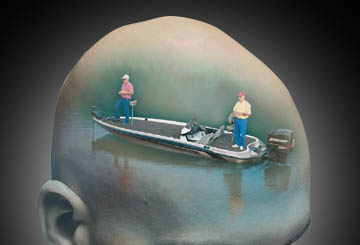Recognize your blind spots

Webster’s dictionary defines blind spot as “an area about which one is uninformed, prejudiced or unaware.” If you fish, especially if you fish competitively, you have at least one, and probably several, fishing blind spots. You might be inclined to think, “Well, so what? Everybody has blind spots; what difference does it make if I have them?” You could certainly think that, in which case you probably won’t find this column all that helpful. However, if you prefer to think that understanding and correcting your blind spots might help you fish better, the information that follows will be worth studying.
Successful performance in all sports, as previous segments in this series have stressed, rests on foundational dimensions of 1) accurate self-awareness; 2) precise, actionable feedback; and 3) unequivocal commitment to improvement. However, it’s pretty difficult to be aware of what you can’t see or fix problems you don’t know are there. Still, there are methods for recognizing and eliminating blind spots, as the following stories will illustrate.
Blind spots can be big and disruptive, though usually they are small and insidious. On a recent walleye trip, we found plenty of postspawn fish stacked up on current breaks in a river system. Over the course of four days, our group landed dozens of fish, several in the 22- to 28-inch range. Fishing nearby were a few other anglers, none of them having the same luck as the guys in our party. Finally, one of the other boats eased over and asked, “OK, what’s the secret?”
Turns out they were fishing with exactly the same lures, line and rod-reel setups we were using. However, there was one significant difference in their technique: While they were drifting along with the current, catching the occasional walleye hugging bottom in the fast water, the guys in our group were fishing currents seams, with most of our fish coming from the slower water of the back eddies. In this particular situation, the walleyes weren’t aggressively snapping, they were actually pretty lethargic, and holding a small jig very still was the key to triggering strikes.
One of our guys said, “You’ve been watching us for the last half-hour. In that time, you’ve made four drifts through this area, probably covering 200 yards each drift; at the same time, I haven’t moved my boat 50 feet. You need to fish a lot slower, and you need to get out of the main current.”
Unfortunately, these particular anglers were unable to recognize their “blind spots,” which in this case were location and lure-presentation speed. They continued to fish the main current because, as their group leader told us back at the dock, “that’s where we found `em last year.”
If you are reasonably self-perceptive, you can probably think of a similar situation or two that applies to your fishing style. For example, how many different retrieve styles/speeds do you really use for the various baits you fish? Most anglers get into a retrieve rhythm they are comfortable with, and then they use that retrieve almost all the time. So with jerkbaits it becomes jerk, jerk, pause – jerk, jerk, pause. Same way with spinnerbaits or crankbaits: Your preferred retrieve might be slow-rolling or burning the bait or some type of medium-speed, stop-and-go method. However, if you use the same retrieve over and over again, even when it’s not working, your retrieve style may have turned into a blind spot.
Here are three techniques that can help you identify potential blind spots.
1) Analyze your own fishing style. For this, you’ll need to buy, borrow or rent a videotaping machine. If you can talk a friend into spending a couple of hours with you in your boat videotaping what you do, fine. Otherwise, get a tripod, focus the camera on where you stand/sit in your boat, and go fishing. Film yourself for at least a couple of hours, and when you get home, review your tape. Competitors in every sport say the same thing, and it goes like this: “Wow! I didn’t know I was doing ________ until I saw myself on tape!” I’m not sure what your “Ah-Ha!” experience will be, but I guarantee that if you watch two hours of yourself fishing, you will notice something about your technique that you didn’t previously know.
2) Stop fishing and watch someone else. This technique works especially well for those of you who fish draw tournaments or pro-am events. While it’s hard to stop fishing and watch someone else on tournament day, see if you can’t set it up to practice fish with a talented colleague or a pro angler. Then set aside three or four 15-minute periods when you put your rod and reel down and pick up a notebook and pencil. For those 15 minutes, pay very close attention to the person in the front of the boat and write down everything you notice about what he or she does. Once again, performance-psychology research and real-life experiences tell us the same thing: Observing experts is a great way to learn; it is also a solid way to uncover and eliminate blind spots.
3) Ask for feedback. In a recent tournament, my mentor Loel was getting waxed by the guy on the trolling motor. Not being shy, Loel finally asked, “What am I doing wrong?” At that point, his pro partner showed him the very small sinker he was using on his Texas-rigged worm. This information allowed Loel to change what clearly had been a blind spot in his approach. The 7-pound, 15-ounce bass he subsequently caught netted him $500, and it, along with a 5-pounder and a couple of smaller fish, put him at eighth place in the final co-angler standings. Loel, not surprisingly, is a strong advocate of eliminating blind spots!
Try these techniques to minimize the negative effects of blind spots, and “see” your fishing improve.

————————————————–
Jay T. McNamara, Ph.D., L.P., also known as Dr. Fish, recently finished his book “The Psychology of Exceptional Fishing.” You can order it by contacting Jay via e-mail at this address: [email protected].
————————————————–
Jay T. McNamara, Ph.D., L.P., is a psychologist, who is also an avid bass and walleye angler. With more than 26 years of professional experience complemented by participation in competitive fishing at local and national levels, he is uniquely qualified to illustrate how performance psychology principles apply to tournament fishing.